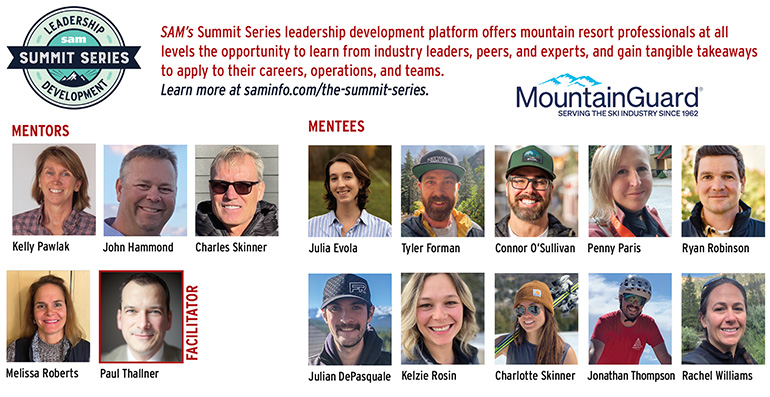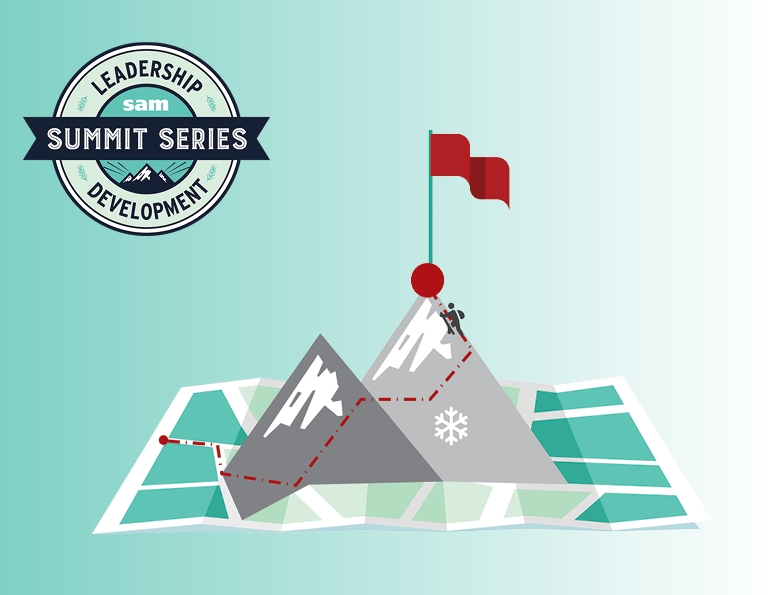
The latest SAM Summit Series discussion brought together the leadership development program’s mentors and mentees to talk about resiliency. With a focus on “reinventing resilience for ourselves,” the conversation explored both individual and organizational resilience and what that means for business success and leadership.
“Is resilience this idea of coming back to shape after being squeezed like a sponge? Or is it more like this idea of withstanding pressure like a steel rod?” asked discussion facilitator Paul Thallner, principal at Dagger Wing Group and author of Reinventing Resilience. “The answer is both and neither—what the common definition of resilience actually fails to consider is that people respond differently than a sponge or a steel rod.”
If you squeeze or try to bend a person, they change as a result, noted Thallner. “So, in reality, resilience is not static the way most people think about it. It’s actually quite dynamic. We have to think about resilience in terms of not just surviving something, but actually growing and evolving and getting a little bit better as a result of being through a challenge.”
RESPONDING WITH RESILIENCE
If resilience is the ability to grow through challenge, how have Summit Series mentors done so in their careers, especially while navigating the ski industry and its weather-, seasonal-, and customer service-related curveballs (not to mention two years of a pandemic)?
“One thing that I think everyone can relate to in our seasonal businesses is that every year you’re starting from scratch,” said mentor and Sugarbush COO John Hammond. “Even though it seems like you’ve got the same people that worked here the last 20 years, you’re still coming back every year wondering how it’s going to go.”
Leadership perspective. Hammond said he’s learned to remember that, even though he’s at the resort year-round, seasonal staff cycle in and out. As a result, one thing he’s realized about “bouncing back” each season is that “as a leader, I needed to slow down, and I also needed to be a better communicator in order to create a resilient organization.”
“The ski industry in general is really a story of resilience,” noted mentor Charles Skinner, president of Midwest Family Ski Resorts. Skinner pointed to the constant fluctuations of the business, “going from quieter during the week to the feeling of being overwhelmed on a Saturday,” and that this can happen for many ski areas throughout the year.
For example, Skinner said, one of his properties—Lutsen Mountains, Minn.—doubled its fall business in 2022, with crowds of visitors putting pressure on staff and operations. “I think that stress is good for people in many ways,” he said. “How you deal with it is how you come out as an individual or an organization.”
Responding resiliently also means listening. Mentor Kelly Pawlak, current president of NSAA and former GM of Mount Snow, Vt., remembers 2011, when Tropical Storm Irene caused historic flooding in southern Vermont. “Everybody was hit so hard, including the ski area,” said Pawlak. “There were literally no roads in or out of my community. One of our housekeepers perished in the storm trying to get home. There was not a business left. My first reaction was, ‘We’ve got to fix this.’”
It was through listening and asking questions that Pawlak realized a need to reassess. “The staff told us what they needed,” she said. “We needed to grieve, and we needed counseling and to help our neighbors. And that’s what we did. We put everything on hold. We were building a lift. We had a beer fest. We just said, ‘we’re closed and we’re going to heal.’ It was probably the first time in my career that I slowed down, and it was a great lesson.”
For Melissa Roberts, general manager at Berkshire East, Mass., reaching out for help has enabled her to become a more resilient leader. “When I was in finance before my GM role, I had a key employee leave right before a major audit. My initial reaction was to work long hours, and just get it done. But some staff members who weren’t really involved stepped forward and asked what they could do. It reinforced to me that it’s OK to rely on other people. It doesn’t make you weak, it’s actually a sign of strength and teamwork.”
CHARACTERISTICS OF RESILIENT PEOPLE
Research shows that highly resilient people tend to possess common traits, namely acceptance, purpose, and flexibility, as well as self-awareness, mindfulness, and the ability to maintain positive relationships. Resilient people are able to access the full range of resources at their disposal, including their own competencies and talents, their value system, their families, and the people and human resources around them.
Confidence is key. “Resilient people typically have a strong belief in their own ability,” said Thallner. “They may not know exactly how they’re going to use their skills, but they generally feel like they are competent and capable. They also see the world clearly and tend to have an accurate assessment of the situation around them. To be able to read the room or the situation accurately—that’s a hallmark of a resilient person.
“Resilient people have a keen awareness of a situation, I call it staunch realism, and a real belief that they can get the job done or get through a challenge. That’s what I call ‘collective efficacy’ in the form of an organization, ‘individual efficacy’ for a person. That’s why we have to be mindful and aware of how we can build up our own resilience, so that we can be more effective in our jobs on a day-to-day basis.”
GROWING RESILIENCY
When it comes to developing resiliency, it’s important to take stock of past successes. “One thing that happens when an organization or an individual gets stuck is they forget that they’ve done great things already,” said Thallner. He recommends that when not under peak stress, a team or individual look back at the organizational history—the wins and moments of triumph as well as moments of difficulty. “This will embed the understanding that we can do it,” said Thallner. “And that’s a hallmark of being resilient, that we can do things that are tough.”
Focus on what you can control. Hammond remembered a few managers he’s seen get overwhelmed over the years and become paralyzed as a result. “You need to focus on what you can control, on what’s going to be the best outcome of the decisions you’re making, and then commit to it,” he noted. “Have the confidence that you’re making the right decision.”
Mentee Jonathan Thompson, a sales manager who started at Winter Park, Colo., in 2021, relayed similar advice he’d gotten from a supervisor at the time.
“He said ‘slow down and focus on what you can control at any given moment,’” said Thompson. “’You’re going to get inquiries every single day, but just take it one step at a time, write it down as a task.’ It’s really helped me to focus on ‘this is what I can get done right now, this is what I can prioritize, and this is what I can do for the future.’”
“We all have important jobs to do,” said Roberts, “and it’s important to remember to take it seriously, but keep it in perspective.”
It is key to have the presence of mind to recognize that when you’re a leader, you’re not only responsible for managing the crisis that’s in front of you, you’re also responsible for managing the response of everybody else, said Thallner. He advised “keeping things focused accurately, reading the situation for what it truly is, and having a proportional response, not freaking out every time something goes wrong, but really making sure that the way you respond is proportional to whatever it is that’s coming at you.”
See the big picture. “One of the things that I’m doing at NSAA is trying to work with the team to really see the big picture,” said Pawlak. At NSAA, the big picture always circles back to the organization’s strategic plan. “Having that big-picture discussion from time to time, even when we get really busy, it gives everybody a good perspective and, quite honestly, lifts them up.”
If one is seeking to learn and grow in their capacity to absorb challenges over time, start taking notes about when you get overwhelmed, stressed, or stuck, recommends Thallner. This helps you to identify patterns so you can better forecast challenges and “create just enough space between the thing and you so that you can respond to it a little bit better every single time.”
STRENGTH IN NUMBERS
There is often resilience in numbers. “I’d add that if you can celebrate the successes, it puts closure and a cap on it and sort of acknowledges what went well or how things were solved,” said Hammond. “It builds the toolbox for you to be able to pull that back out and say, ‘we’ve seen this before. We know that we can get through that.’”
“It isn’t an ‘I,’ it’s a ‘we,’” added Roberts. “Focusing on the team, and breaking it down into small pieces, and figuring out how and what are the critical pieces that need to be done, and getting those done. Work on it iteratively rather than trying to tackle it all at once.”
Roberts noted that people want to feel involved, too. She recalls a time when she was at Smugglers’ Notch, Vt., where finances called for company-wide pay cuts. “We were as transparent as we could be saying, ‘if we’re able to make these certain revenue and expense targets, you guys will get it back. And depending on how much we exceed it, you’ll actually get a bonus, too.’ We more than exceeded the goal and were able to pay everybody back plus a bonus. So having people feel involved rather than just a cog in the wheel, I think really makes a big difference [in being resilient].”
THE KEY
“The key for me is having a positive outlook and really enjoying what I do,” said Hammond. “We do adventuring—camaraderie is sort of why we’re here. And when you can say, ‘we’re doing this because we’re building the storytelling of the adventure and building these friendships,’ that makes you much more resilient.”
Read More About Resilience
This Summit Series session’s facilitator, Paul Thallner, is the author of Reinventing Resilience, a new book about how organizations move beyond setbacks to grow through challenges.
Find it on Amazon.com.






